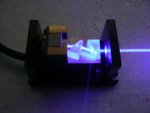@ rhd: if they are uncoated, there's a good possibility that you loss a lot of power (maybe 20 or 25%), cause the faces acts as "splitters", reflecting a lot ..... if they are broadband coated, is not specific for blue, but is always better than nothing (and, probably, they are broadband coated, cause right angle prisms was used in binoculars for image inversion and "compact" the size of the binocular body).
If they are red or IR coated, they are worse than uncoated (IR coating reflect blue)
@ steve001: Anchor sell "wedge" prisms, but they are cylindricals, and this means you have to use a specific mounting set, for them (and is difficunt to align the rotation plane, too) ..... about the cylindrical lenses, i already thoughd about them, but the difficult, for a handheld mount, is to find a lens with the correct diameter and FL.
As example, the concave ones can be used for "enlarge" the slow axis, then you can use a bigger diameter lens for focus the resulting beam for distance (same as using a beam expander, but having it incorporated in the unit) ..... this, for the other side, prevent you to have a thin beam at short distance, or to have a burning spot at short range.
Positive (convex) lenses, can help you "squeezing" the fast axis, giving you a better thin beam at short distance, and a rounder shaped spot, but, ofcourse, increase a bit the divergence in long range ..... also, for be efficent and not change the whole assembly, it must be glued in front of the diode, and this require a "round shaped" cylindrical lens with 4mm to 5mm (max) diameter, one flat side, AR coating for 400 to 500 nm or similar, and a FL of 3mm to 3.5mm ..... other than this, it must be in glass, resisting to the heat (if you want to use it with 445nm diodes), and finally you need to align it on the top of your diode case and glue it with thermally resistent glue ..... this is basically the only way for use our 9mm lens holders and achieve a round beam in an handheld unit, without modify it.
The only other option is to use a larger front lens, but this give you the "beam expander" size beam, and also constrain you to modify all the "standard" existing heatsinks, modules and lens holders.
This ofcourse is not valid for labby style units, where you can have all the space you want.




